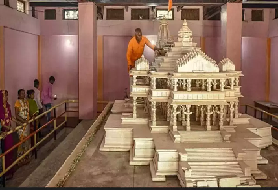The Ram Temple in Ayodhya will have a three-foot-long idol of Lord Ram. The upcoming temple will also have original Ram Lall idols. According to reports, the Shaligram stones from which the new idols will be carved out have been dispatched by Nepal.
Notably, idols of lord Ram and Janki will be carved out from these stones. The idols are expected to be placed in the main temple complex of the under-construction Ram Mandir. Notably, on Sunday Nepal will dispatch these stones on January 30. These stones were extracted from the Kaligandaki river.
The government of Nepal’s Ganki state handed over these stones to Janakpur’s Janaki Temple. The two stones are weighing 23 and 15 tons respectively. Nepal made all the arrangements for dispatching these stones to Ayodhya.
Nepali Congress leader and former deputy prime minister Bimalendra Nidhi is reportedly coordinating with the Janaki temple. Experts believe that the development will boost tourism in the Kaligandki area and also strengthen religious tourism between India and Nepal.
These stones will reportedly be sent to Ayodhya in a procession. On December 15, the cabinet of Nepal took the decision to send these Shilagram stones to India. “Stones found in the Kaligandki River are well known and very precious in the world. It is widely accepted that these stones are symbols of Lord Vishnu. Lord Ram is the incarnation of Bhagwan Vishnu which is why the stone from Kali Gandaki River, if available, would be very good to make Ram Lala’s murti (Idol) in Ayodhya for Ram Janma Bhumi Temple,” Nidhi said as quoted by ANI.
The Sher Bahadur Deuba government had authorised handing over the Shaligram stones to Ayodhya. “As the Shaligram start moving towards Ayodhya, words about the importance of Shaligram/ Shila and Kaligandaki would be known to a large mass of people. This would increase the arrival of Hindus and this place would be known for its religious tourism,” Chairman of Myagdi’s Galeshwor Shivalaya Area development trust, Madhav Prasad Regmi told News agency ANI.
The Ram Temple is likely to be inaugurated in January 2024.



